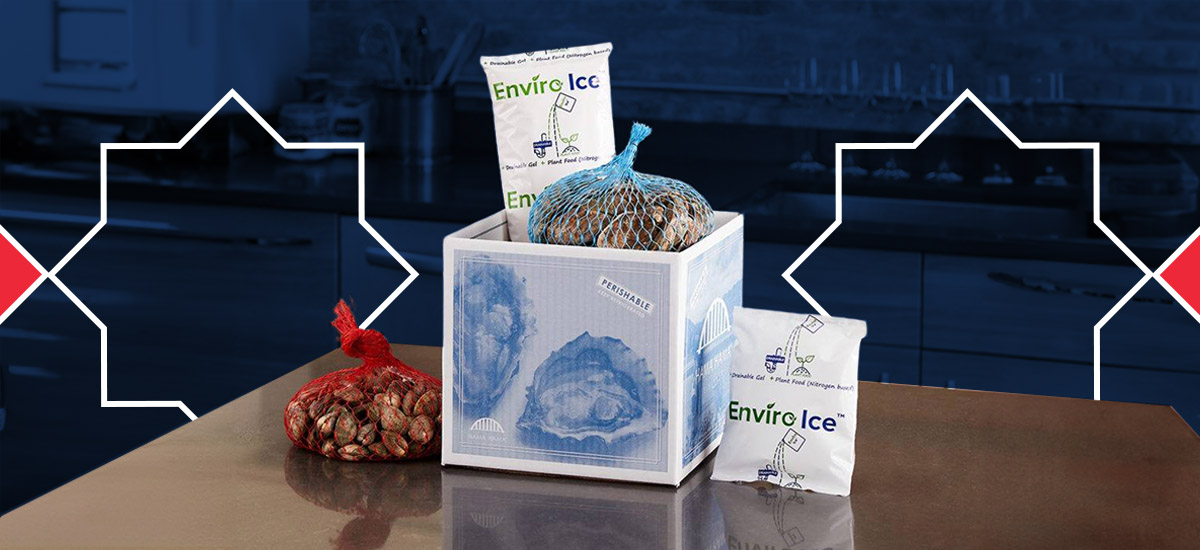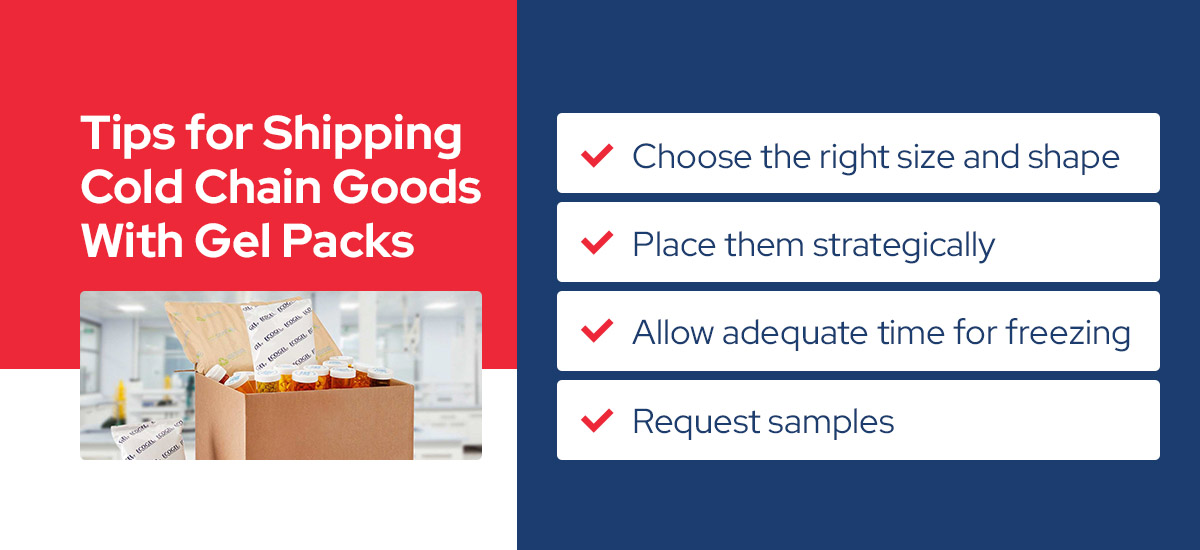
Cold chain logistics is constantly evolving — and presenting new challenges along the way. With surging e-commerce sales and rising fuel costs, cold chain shippers must seek ways to mitigate shipping expenses while meeting increased consumer demand for direct-to-doorstep perishables. Additionally, the growing pressure to commit to climate action has businesses searching for more sustainable cold chain practices to stay competitive.
There’s a simple solution that can ease some of the friction — cost-effective and eco-friendly gel packs.
What Is a Gel Pack?
Gel packs are refrigerant solutions designed to prevent temperature excursions within an insulated shipping container. They cost less than electric-powered temperature control devices and are available in sustainable designs.
Though specific gel pack compositions vary, these solutions typically involve a specially formulated, water-based gel contained within a durable plastic pouch. Gel packs may be used frozen or refrigerated depending on the shipped products’ temperature requirements, transit duration and environmental conditions.
A water-based frozen gel pack removes and absorbs ambient heat during transport without undergoing a significant temperature change, allowing gradual thawing. That’s because water has an exceptionally high latent heat of fusion, which is the amount of heat required for a solid substance to transition into a liquid. A frozen gel pack can absorb a significant quantity of heat without its temperature rising substantially, allowing it to provide a steady cooling effect during shipment.
Refrigerated gel packs, which work well for applications such as shipping nonfrozen perishables in cold weather, act as heat sinks by absorbing and storing ambient heat without any phase change while still helping to maintain cool temperatures in the shipping container.
What Industries Benefit the Most From Gel Packs for Shipping?
Industries that must adhere to strict temperature requirements to ensure product quality and safety, such as the pharmaceutical and food industries, benefit most from shipping gel packs. Gel packs help cold chain shippers in these industries mitigate in-transit temperature excursions. However, any business needing to ship or deliver temperature-sensitive goods can benefit from gel packs, including those within the agricultural, floral and personal care industries.
Gel packs are an advantageous shipping solution because they’re flexible, effective and affordable. For example, unlike electrical cooling systems, gel packs are lightweight and don’t involve equipment maintenance, thereby reducing freight and upkeep costs. They are also easy and safe to handle, unlike dry ice. Their simplicity and low cost make them ideal for one-way shipments, such as with direct-to-consumer delivery of pharmaceuticals or meal kits.
Tips for Shipping Cold Chain Goods With Gel Packs
If you’re considering incorporating gel packs into your cold chain, the following tips can help you get started:
- Choose the right size and shape: Choosing the correct gel pack size and shape will help you maximize shipping container space, reduce in-transit movement and optimize gel pack performance. The gel pack’s dimensions should enable it to fit tightly in the shipping container, along with the insulating materials, to ensure efficient cooling.
- Place them strategically: Place gel packs evenly around the product to ensure uniform cooling. For example, you might place a gel pack on the bottom, sides and top of a shipping container. You could then add an insulating layer, such as bubble wrap or brown paper, to keep products that should not be over-chilled from directly contacting frozen gel packs.
- Allow adequate time for freezing: If your shipment requires frozen gel packs for adequate temperature control, consider the gel pack’s freezing timeline to help plan your shipment schedule. For example, a full pallet of Pelton Shepherd gel packs delivered at ambient temperature requires a minimum of 21 days for freezing in a typical 0F cold storage facility. When using a blast freezing facility, the pallet conditioning time can be as low as 5 days . In general, you can reduce the timeline by refrigerating gel packs prior to freezing or increasing air circulation between packs.
- Request samples: Consider testing gel pack samples before ordering at scale to ensure they meet your temperature control and packaging requirements. If the sample does not meet your needs, you might consider custom options. We’re happy to discuss gel pack samples or customization with you so you can feel confident about your order. Please contact us to learn more.
For more tips, see our Complete Guide to Cold Chain Shipping.
FAQs
View our FAQs below to learn more about gel packs. If you still have questions, our team is ready to answer them.
How Long Do Gel Packs Last?
Gel packs can generally maintain their cooling properties for up to two days. For example, a well-insulated shipping container with enough frozen gel packs to cover at least two faces should maintain its internal temperature for up to 48 hours when transported in the summer.
That said, a gel pack could remain cold for a longer or shorter duration depending on factors such as the gel pack’s design, environmental temperatures, shipping container thickness, number of packs used and transit duration.
What Are Common Regulations Around Shipping Gel Packs?
Regulations surrounding gel packs depend on the type of product being shipped and the mode of transportation. These factors determine the regulatory body or bodies overseeing the shipment and its contents.
For example, if you’re shipping biological samples by air, you may need to adhere to regulations set by the International Air Transport Association (IATA). IATA annually publishes Temperature Control Regulations, which include compliance requirements.
If you ship food products domestically, the Food and Drug Administration (FDA) may have regulations that apply to you. For instance, the Sanitary Transportation of Human and Animal Food rule, part of the FDA’s Food Safety Modernization Act, establishes requirements for ensuring food safety during transport. It applies to shippers who transport food by motor or rail.
Other regulatory bodies that may have regulations relevant to your shipments include the Department of Transportation, the United States Postal Service, the United States Department of Agriculture and — if you ship products overseas — various international authorities.
How Many Gel Packs Are Needed for Shipping?
As a general rule, plan to pack 1 pound of gel pack for every 2 pounds of product. However, the precise number of gel packs required to maintain your cold chain will depend on transport duration, ambient temperature, container size and product volume.
Where Can I Buy Gel Packs for Shipping?
You can buy gel packs from packaging suppliers or directly from gel pack manufacturers. Purchasing from a gel pack manufacturer can be ideal if you need a large order, such as one or more pallets of gel packs. It also allows you access to the manufacturer’s industry expertise and provides various cold pack options. Another benefit of buying directly from the manufacturer is that it eliminates the cost of dealing with intermediaries.
Keep Your Shipments Cool With Pelton Shepherd
From temperature deviations to sustainability pressures, cold chain shippers have much to consider. At Pelton Shepherd, we know the industry inside and out and have designed reliable refrigerant solutions to bring businesses peace of mind.
We’re a family-operated gel pack innovator and manufacturer with over 70 years of experience in the field. We offer a wide selection of cold pack designs and formulations, including uniquely designed sustainable gel packs, to meet the diverse needs of our customers in evolving markets.
Contact our team today to learn more about our cold chain solutions.




